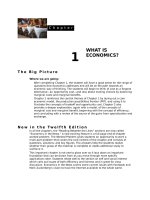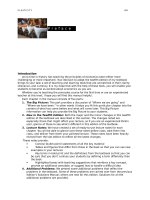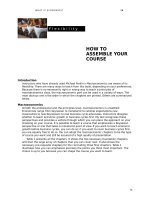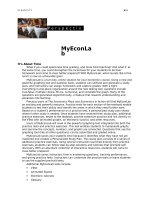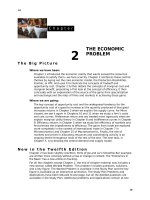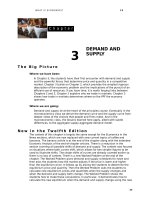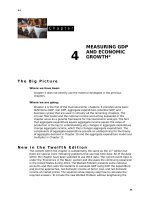Answers to review quizzes marcroeconomics 12e parkin chapter appendix 1200
Bạn đang xem bản rút gọn của tài liệu. Xem và tải ngay bản đầy đủ của tài liệu tại đây (1.01 MB, 14 trang )
W H AT I S E C O N O M I C S ?
9
Appendix
1
GRAPHS IN
ECONOMICS
Answers to the Review Quiz
Page 66
1.
Explain how we “read” the three graphs in Figs. A1.1 and A1.2.
The points in the graphs relate the quantity of the variable measured on the one
axis to the quantity of the variable measured on the other axis. The quantity of the
variable measured on the horizontal axis (the x-axis) is measured by the
horizontal distance from the origin to the point. Similarly, the quantity of the
variable measured on the vertical axis (the y-axis) is measured by the vertical
distance from the origin to the point. The point relates these two quantities. For
instance, in Figure A1.2a, point A shows that at a price of $1.37 per song, 3.8
million songs are downloaded.
2.
Explain what scatter diagrams show and why we use them.
Scatter diagrams plot the value of one economic variable against the value of
another variable for a number of different values of each variable. We use scatter
diagrams because they quickly reveal if a relationship exists between the two
variables. Moreover, if a relationship exists, scatter diagrams show whether
increases in one variable are associated with increases or decreases in the other
variable.
3.
Explain how we “read” the three scatter diagrams in Figs. A1.3 and A1.4.
The scatter diagram in Figure A1.3 shows the relationship between box office ticket
sales and DVDs sold for 9 popular movies. The figure shows that higher box office
sales are associated with a higher number of DVDs sold. But the figure shows that
the relationship is weak.
The scatter diagram in Figure A1.4a shows the relationship between income, in
thousands of dollars per year, and expenditure, also in thousands of dollars per
year, for the years 2001 to 2011. The scatter diagram shows that higher income
leads to higher expenditure. The figure also shows that the relationship is relatively
strong.
The scatter diagram in Figure A1.4b shows the relationship between the inflation
rate and the unemployment rate for the years 2001 to 2011. The figure shows that
9
10
for most of the years, there was a weak relationship between these variables, with
perhaps higher inflation being associated with lower unemployment.
10
4.
Draw a graph to show the relationship between two variables that move in
the same direction.
A graph that shows the relationship
between two variables that move in the
same direction is shown by a line that
slopes upward. Figure A1.1 illustrates
such a relationship.
5.
Draw a graph to show the relationship between two variables that move in
opposite directions.
A graph that shows the relationship
between two variables that move in the
opposite directions is shown by a line
that slopes downward. Figure A1.2
illustrates such a relationship.
G RA PH S IN E C O N OM I CS
6.
Draw a graph of two variables whose relationship shows (i) a maximum and
(ii) a minimum.
A graph that shows the
relationship between two variables
that have a maximum is shown by
a line that starts out sloping
upward, reaches a maximum, and
then slopes downward. Figure A1.3
illustrates such a relationship with
curve B.
A graph that shows the
relationship between two variables
that have a minimum is shown by
a line that starts out sloping
downward, reaches a minimum,
and then slopes upward. Figure
A1.3 illustrates such a relationship
with curve A.
7.
Which of the relationships in
Questions 4 and 5 is a positive
relationship and which is a negative relationship?
The relationship in Question 4 between the two variables that move in the same
direction is a positive relationship. The relationship in Question 5 between the two
variables that move in the opposite directions is a negative relationship.
8.
What are the two ways of calculating the slope of a curved line?
To calculate the slope of a curved line we can calculate the slope at a
point or across an arc. The slope of a curved line at a point on the line is defined
as the slope of the straight line tangent to the curved line at that point. The slope
of a curved line across an arc—between two points on the curved line—equals the
slope of the straight line between the two points.
9.
How do we graph a relationship among more than two variables?
To graph a relationship among more than two variables, hold constant the values
of all the variables except two. Then plot the value of one of the variables against
the other variable.
10.
Explain what change will bring a movement along a curve.
A movement along a curve occurs when the value of a variable on one of the axes
changes while all of the other relevant variables not graphed on the axes do not
change. The movement along the curve shows the effect of the variable that
changes, ceteris paribus (holding all of the other non-graphed variables constant).
11.
Explain what change will bring a shift of a curve.
A curve shifts when there is a change in the value of a relevant variable that is not
graphed on the axes. In this case the entire curve shifts.
9
10
APPENDIX 1
Answers to the Study Plan Problems and
Applications
Use the spreadsheet to work
Problems 1 to 3. The spreadsheet
provides data on the U.S. economy:
Column A is the year, column B is the
inflation rate, column C is the
interest rate, column D is the growth
rate, and column E is the
unemployment rate.
1.
1
2
3
4
5
6
7
8
9
10
11
A
2003
2004
2005
2006
2007
2008
2009
2010
2011
2012
2013
B
1.6
2.3
2.7
3.4
3.2
2.9
3.8
−0.3
1.6
3,1
2.1
C
1.0
1.4
3.2
4.9
4.5
1.4
0.2
0.1
0.1
0.1
0.1
D
2.8
3.8
3.4
2.7
1.8
−0.3
−2.8
2.5
1.8
2.8
1.9
E
6.0
5.5
5.1
4.6
4.6
5.8
9.3
9.6
8.9
8.1
7.4
Draw a scatter diagram of the inflation rate and the interest rate. Describe
the relationship.
To make a scatter diagram of the inflation rate and the interest rate, plot the
inflation rate on the x-axis and the interest rate on the y-axis. The graph will be a
set of dots and is shown in Figure A1.4. The pattern made by the dots tells us that
as the inflation rate increases, the interest rate usually increases so there is a
(weak) positive relationship.
2.
Draw a scatter diagram of the growth rate and the unemployment rate.
Describe the relationship.
To make a scatter diagram of the growth rate and the unemployment rate, plot the
growth rate on the x-axis and the unemployment rate on the y-axis. The graph will
be a set of dots and is shown in Figure A1.5. The pattern made by the dots tells us
that when the growth rate increases, the unemployment rate usually decreases so
there is a negative relationship.
G RA PH S IN E C O N OM I CS
3.
Draw a scatter diagram of the interest rate and the unemployment rate.
Describe the relationship.
To make a scatter diagram of the
interest rate and the unemployment
rate, plot the interest rate on the xaxis and the unemployment rate on
the y-axis. The graph will be a set of
dots and is shown in Figure A1.6. The
pattern made by the dots tells us that
when the interest rate increases, the
unemployment rate usually decreases
so there is a negative relationship.
Use the following news clip to work Problems 4 to 6.
Lego Shatters More Records:
Source: Boxofficemojo.com,
Data for weekend of February 1417, 2014
4.
Draw a graph of the
relationship between the
revenue per theater on the yaxis and the number of
theaters on the x-axis.
Describe the relationship.
Movie
The LEGO Movie
About Last Night
RoboCop
The Monument
Men
Figure A1.7 shows the
relationship. As the figure shows, there is
a positive relationship.
5.
Calculate the slope of the relationship
between 3,775 and 2,253 theaters.
The slope equals the change in revenue
per theater divided by the change in the
number of theaters. The slope equals
($16,551 $12,356)/(3,775 2,253) which
equals $2.76 per theater.
6.
Calculate the slope of the relationship in
Problem 4 between 2,253 and 3,372
theaters.
The slope equals the change in revenue
per theater divided by the change in the
number of theaters. The slope equals
Theate
rs
(numb
er)
3,775
2,253
3,372
3,083
Revenue
(dollars per
theater)
$16,551
$12,356
$7,432
$5,811
11
12
APPENDIX 1
($12,356 $7,432)/(2,253 3,372 which equals −$4.40 per theater.
7.
Calculate the slope of the relationship
shown in Figure A1.8.
The slope is 5/4. The curve is a straight
line, so its slope is the same at all points
on the curve. Slope equals the change in
the variable on the y-axis divided by the
change in the variable on the x-axis. To
calculate the slope, you must select two
points on the line. One point is at 10 on
the y-axis and 0 on the x-axis, and
another is at 8 on the x-axis and 0 on
the y-axis. The change in y from 10 to 0
is associated with the change in x from 0
to 8. Therefore the slope of the curve
equals 10/8, which equals 5/4.
Use the relationship shown in Figure A1.9 to
work Problems 8 and 9.
8.
Calculate the slope of the relationship
at point A and at point B.
The slope at point A is 2, and the slope
at point B is 0.25. To calculate the slope
at a point on a curved line, draw the
tangent to the curved line at the point.
Then find a second point on the tangent
and calculate the slope of the tangent.
The tangent at point A cuts the y-axis at
10. The slope of the tangent equals the
change in y divided by the change in x.
The change in y equals 4 (6 minus 10)
and the change in x equals 2 (2 minus
0). The slope at point A is 4/2, which
equals 2.
Similarly, the slope at point B is 0.25.
The tangent at point B goes through the point (4, 2). The change in y equals 0.5,
and the change in x equals 2. The slope at point B is 0.25.
G RA PH S IN E C O N OM I CS
9.
Calculate the slope across the arc
AB.
The slope across the arc AB is
1.125. The slope across an arc AB
equals the change in y, which is
4.5 (6.0 minus 1.5) divided by the
change in x, which equals 4 (2
minus 6). The slope across the arc
AB equals 4.5/4, which is 1.125.
Price
(dollars
per ride)
5
10
15
Balloon rides
(number per day)
50F
70F
90F
32
40
50
27
32
40
18
27
32
13
14
APPENDIX 1
Use the table to work Problems 10 and 11. The table gives the price of a balloon
ride, the temperature, and the number of rides a day.
10.
Draw a graph to show the relationship
between the price and the number of
rides, when temperature is 70°F.
Describe this relationship.
Figure A1.10 shows the relationship
between the price and the number of
balloon rides when the temperature is
70F. The relationship between the price
and the number of rides is inverse; that
is, when the price rises, the number of
rides decreases.
11.
What happens in the graph in Problem
10 if the temperature rises to 90°F?
If the temperature rises to 90F, the
curve shifts rightward. This shift is
illustrated in Figure A1.11. In that figure,
both the initial curve, which applies
when the temperature is 70F, and the
new curve, which applies when the
temperature is 90F, are illustrated. The
curve when the temperature is 90F lies
to the right of the curve when the
temperature is 70F indicating that at
every price, more balloon rides are
taken when the temperature is 90F
rather than 70F.
G RA PH S IN E C O N OM I CS
Answers to Additional Problems and Applications
Use the spreadsheet to work
Problems 12 to 14. The
spreadsheet provides data on oil
and gasoline: Column A is the
year, column B is the price of oil
(dollars per barrel), column C is
the price of gasoline (cents per
gallon), column D is U.S. oil
production, and column E is the
U.S. quantity of gasoline refined
(both in millions of barrels per
day).
12.
1
2
3
4
5
6
7
8
9
10
11
A
2003
2004
2005
2006
2007
2008
2009
2010
2011
2012
2013
B
31
42
57
66
72
100
62
79
95
94
98
C
160
190
231
262
284
330
241
284
354
364
353
D
5.7
5.4
5.2
5.1
5.1
5.0
5.4
5.5
5.7
6.5
7.5
E
8.9
9.1
9.2
9.3
9.3
9.0
9.0
9.0
9.1
9.0
9.1
Draw a scatter diagram of the price of oil and the quantity of U.S. oil
produced. Describe the relationship.
Figure A1.12 shows the scatter diagram between the price of a barrel of oil and the
quantity of U.S. oil produced. It shows a very weak relationship.
13.
Draw a scatter diagram of the price of gasoline and the quantity of gasoline
refined. Describe the relationship.
Figure A1.13 shows the scatter diagram between the price of a gallon of gasoline
and the quantity of gasoline refined. It shows a weak positive relationship.
15
16
14.
APPENDIX 1
Draw a scatter diagram of the quantity of U.S. oil produced and the quantity
of gasoline refined. Describe the
relationship.
Figure A1.14 shows the scatter diagram
between the quantity of U.S. oil
produced and the quantity of gasoline
refined. It shows a negative
relationship.
Use the following data to work
Problems 15 to 17.
Draw a graph that shows the
relationship between the two variables
x and y in the table to the right.
x
0
1
2
3
y
25
24
22
18
5
4
12
0
To make a graph that shows the
relationship between x and y, plot the x
variable on the x-axis and the y variable
on the y-axis. Figure A1.15 shows this
graph.
15.a. Is the relationship positive or negative?
The relationship is negative because x and
y move in opposite directions: As x
increases, y decreases.
b. Does the slope of the relationship
become steeper or flatter as the value
of x increases?
The slope becomes steeper as x increases.
c. Think of some economic relationships
that might be similar to this one.
The less expensive a good, the greater is
the number of people who buy it. The higher the interest rate, the smaller is the
number of people who take out home mortgages. The less expensive gasoline, the
greater the miles car owners drive.
16.
Calculate the slope of the relationship between x and y when x equals 3.
The slope equals 4.0. The slope of the curve at the point where x is 3 is equal to
the slope of the tangent to the curve at that point. Plot the relationship and then
draw the tangent line at the point where x is 3 and y is 18. Now calculate the slope
G RA PH S IN E C O N OM I CS
of this tangent line by finding another point on the tangent. When x equals 5, y
equals 10 on the tangent, so another point is x equals 5 and y equals 10. The slope
equals the change in y, 8, divided by the change in x, 2, so the slope is 4.0.
17.
Calculate the slope of the relationship across the arc as x increases from 4 to
5.
The slope is –12. The slope of the relationship across the arc when x increases from
4 to 5 is equal to the slope of the straight line joining the points on the curve at x
equals 4 and x equals 5. When x increases from 4 to 5, y falls from 12 to 0. The
slope equals the change in y, 12 (12 minus 0), divided by the change in x, 1 (4
minus 5), so the slope across the arc is 12.0.
18.
Calculate the slope of the curve in
Figure A1.16 at point A.
The slope is 2. The curve is a straight
line, so its slope is the same at all
points on the curve. Slope equals the
change in the variable on the y-axis
divided by the change in the variable
on the x-axis. To calculate the slope,
select two points on the line. One point
is at 18 on the y-axis and 0 on the xaxis, and another is at 9 on the x-axis
and 0 on the y-axis. The change in y
from 18 to 0 is associated with the
change in x from 0 to 9. Therefore the
slope of the curve equals 18/9, which
equals 2.
Use Figure A1.17to work Problems 19 and 20.
19. Calculate the slope at point A and at
point B.
The slope at point A is 4, and the slope
at point B is 1. To calculate the slope at
a point on a curved line, draw the
tangent to the line at the point. Then
find a second point on the tangent and
calculate the slope of the tangent.
The tangent at point A cuts the x-axis
at 2.5. The slope of the tangent equals
the change in y divided by the change
in x. The change in y equals 6 (6 minus
0) and the change in x equals 1.5 (1
minus 2.5). The slope at point A is
6/1.5, which equals 4. Similarly, the
slope at point B is 1. The tangent at
17
18
APPENDIX 1
point B cuts the y-axis at 5. The change in y equals 3, and the change in x equals
3. The slope at point B is 1.
20.
Calculate the slope across the arc AB.
The slope across the arc AB is 2. The slope across the arc AB equals the change in
y, which is 4 (6 minus 2) divided by the change in x, which equals 2 (1 minus 3).
The slope across the arc AB equals 4/2, which equals 2.
Use the following table to work Problems
21 to 23.
The table gives information about
umbrellas: price, the number purchased,
and rainfall in inches.
21.
Draw a graph to show the
relationship between the price and
the number of umbrellas purchased,
holding the amount of rainfall
constant at 1 inch. Describe this
relationship.
Price
(dollars
per
umbrella
)
20
30
40
Umbrellas
(numbers per day)
0
1
2
(inches of rainfall)
4
2
1
7
4
2
8
7
4
Figure A1.18 shows the relationship. To draw a graph of the relationship between
the price and the number of umbrellas
when the rainfall equals 1 inch, keep the
rainfall at 1 inch and plot the data in that
column against the price. This curve is
the relationship between price and
number of umbrellas when the rainfall is
1 inches. The relationship between the
price and the number of umbrellas is an
inverse relationship; as the price rises,
the number of umbrellas decreases.
22.
What happens in the graph in Problem
21 if the price rises and rainfall is
constant?
If the price rises, the number of umbrellas
decreases. In Figure A1.18, there is a
movement upward along the
(unchanged) curve.
23.
What happens in the graph in Problem
21 if the rainfall increases from 1 inch to
2 inches?
As shown in Figure A1.19, the curve shifts
rightward. In that figure, both the initial
curve, which applies when the rainfall is
1 inch, and the new curve, which applies
when the rainfall is 2 inches, are
illustrated. The curve when the rainfall is
2 inches lies to the right of the curve
when the rainfall is 1 inch indicating that
G RA PH S IN E C O N OM I CS
at every price, more umbrellas are purchased when the rainfall is 2 inches than
when the rainfall is 1 inch.
19


